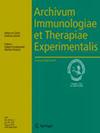急性肺栓塞与动物模型的免疫力
IF 2.9
4区 医学
Q3 IMMUNOLOGY
引用次数: 0
摘要
静脉血栓栓塞症包括急性肺栓塞(APE)和深静脉血栓形成(DVT),是一种潜在的致命疾病,其病理生理学十分复杂。传统上,Virchow 三要素为了解血栓形成的致病因素提供了一个框架,其中包括内皮功能障碍、血流改变和血液高凝状态。近些年来,免疫在血栓形成中显然发挥着核心作用,与传统的促血栓形成机制、氧化应激和血管因素相互作用。血栓形成会放大炎症反应,夸张的炎症过程会引发血栓形成,这主要是由于白细胞、血小板和内皮细胞被激活所致。与 APE 相关的内皮损伤是激活免疫系统的主要诱因。内皮也是介导炎症反应的关键成分,与维持血管通透性有关。右心室壁应力和负荷过大,同时伴有全身性低血压和低氧血症,导致心肌损伤和坏死。缺氧、组织因子激活和细胞因子风暴参与了血栓-炎症过程。血栓形成的特点是血管壁处于炎症状态,主要是由于早期白细胞外渗以及大量选择素和细胞因子的产生。然而,深静脉血栓的免疫性已被充分描述,但对于静脉内形成的血栓与脱落并滞留在肺循环中的血栓之间潜在的趋化因子和细胞差异却知之甚少,而这正是导致 APE 的原因之一。关于肺动脉栓塞急性发作时肺动脉壁的炎症状态的数据很少。本综述的主要目的是总结实验模型中肺栓塞急性期的免疫知识。本文章由计算机程序翻译,如有差异,请以英文原文为准。
Acute Pulmonary Embolism and Immunity in Animal Models
Venous thromboembolism, encompassing acute pulmonary embolism (APE) and deep vein thrombosis (DVT), is a potentially fatal disease with complex pathophysiology. Traditionally, the Virchow triad provided a framework for understanding the pathogenic contributors to thrombus formation, which include endothelial dysfunction, alterations in blood flow and blood hypercoagulability. In the last years, it has become apparent that immunity plays a central role in thrombosis, interacting with classical prothrombotic mechanisms, oxidative stress and vascular factors. Thrombosis amplifies inflammation, and exaggerated inflammatory processes can trigger thrombosis mainly due to the activation of leukocytes, platelets, and endothelial cells. APE-related endothelium injury is a major trigger for immune system activation. Endothelium is also a key component mediating inflammatory reaction and it is relevant to maintain vascular permeability. Exaggerated right ventricular wall stress and overload, with coexisting systemic hypotension and hypoxemia, result in myocardial injury and necrosis. Hypoxia, tissue factor activation and cytokine storm are engaged in the thrombo-inflammatory processes. Thrombus development is characterized by inflammatory state vascular wall caused mainly by an early extravasation of leukocytes and intense selectins and cytokines production. Nevertheless, immunity of DVT is well described, little is known about potential chemokine and cellular differences between thrombus that develops in the vein and thrombus that detaches and lodges in the pulmonary circulation being a cause of APE. There is a paucity of data considering inflammatory state in the pulmonary artery wall during an acute episode of pulmonary embolism. The main aim of this review is to summarize the knowledge of immunity in acute phase of pulmonary embolism in experimental models.
求助全文
通过发布文献求助,成功后即可免费获取论文全文。
去求助
来源期刊
CiteScore
5.90
自引率
0.00%
发文量
26
审稿时长
>12 weeks
期刊介绍:
Archivum Immunologiae et Therapiae Experimentalis (AITE), founded in 1953 by Ludwik Hirszfeld, is a bimonthly, multidisciplinary journal. It publishes reviews and full original papers dealing with immunology, experimental therapy, immunogenetics, transplantation, microbiology, immunochemistry and ethics in science.

 求助内容:
求助内容: 应助结果提醒方式:
应助结果提醒方式:


